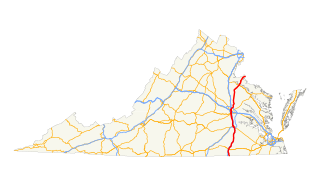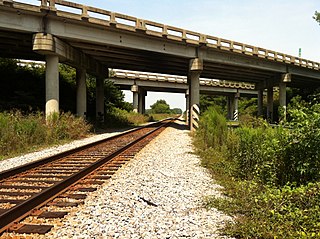
The Richmond, Fredericksburg, and Potomac Railroad was a railroad connecting Richmond, Virginia, to Washington, D.C. The track is now the RF&P Subdivision of the CSX Transportation system; the original corporation is no longer a railroad company.

The Atlantic Coast Line Railroad is a former U. S. Class I railroad from 1900 until 1967, when it merged with long-time rival Seaboard Air Line Railroad to form the Seaboard Coast Line Railroad. Much of the original ACL network has been part of CSX Transportation since 1986.
Most CSX railroad lines are given lettered prefixes before milepost numbers. These prefixes are one to three letters long with the first letter usually refer to the former company. For instance, prefixes beginning with "S" were part of the Seaboard Air Line Railroad. Some of these company prefixes include the following:

State Route 161 is a primary state highway in and near Richmond, Virginia, United States. It extends from an interchange with Interstate 95 in the independent city of Richmond north to an intersection with U.S. Route 1 in the Lakeside area of central Henrico County.
Originally chartered in 1835 as the Wilmington and Raleigh Railroad, the Wilmington and Weldon Railroad (W&W) name began use in 1855. At the time of its 1840 completion, the line was the longest railroad in the world with 161.5 miles (259.9 km) of track. It was constructed in 4 ft 8 in gauge. At its terminus in Weldon, North Carolina, it connected with the Seaboard and Roanoke Railroad and the Petersburg Railroad. The railroad also gave rise to the city of Goldsboro, North Carolina, the midpoint of the W&W RR and the railroad intersection with the North Carolina Railroad.
The Richmond and Petersburg Railroad moved passengers and goods between Richmond and Petersburg from 1838 to 1898. It survived the American Civil War and eventually merged into the Atlantic Coast Line Railroad in 1900.
The Petersburg Railroad ran from Petersburg, Virginia, south to Garysburg, North Carolina, from which it ran to Weldon via trackage rights over the Seaboard and Roanoke Railroad.

U.S. Route 301 is a part of the U.S. Highway System that runs from Sarasota, Florida to Biddles Corner, Delaware. In Virginia, the U.S. Highway runs 142.70 miles (229.65 km) from the North Carolina state line near Skippers north to the Maryland state line at the Potomac River near Dahlgren. US 301 forms the local complement to Interstate 95 (I-95) from Emporia to Petersburg. The U.S. Highway runs concurrently with US 1 between Petersburg and the state capital of Richmond, where the highways form one of the main north–south avenues. US 301 continues north concurrent with Virginia State Route 2 to Bowling Green, forming an eastern alternative to I-95 and US 1 north of Richmond. At Bowling Green, which is connected to I-95 by SR 207, US 301 becomes the primary highway connecting Richmond and the Northern Neck with Southern Maryland. US 301 was constructed in four main segments: as the original SR 24 and then US 17-1 south of Petersburg, as US 1 from Petersburg to Richmond, as SR 2 from Richmond to Bowling Green, and as part of SR 207 toward Dahlgren. US 301 replaced US 17-1 in the early 1930s and was extended from Petersburg north along its current course into Maryland when the Potomac River Bridge was completed in 1940.
U.S. Route 1 (US 1) is a major north–south U.S. Highway that serves the East Coast of the United States. In the U.S. state of Virginia, US 1 runs north–south through South Hill, Petersburg, Richmond, Fredericksburg, and Alexandria on its way from North Carolina to the 14th Street Bridge into the District of Columbia. It is completely paralleled by Interstate Highways in Virginia – Interstate 85 (I-85) south of Petersburg, I-95 north to Alexandria, and I-395 into the District – and now serves mainly local traffic. At its north end, on the approach to the 14th Street Bridge, US 1 is concurrent with I-395; the rest of US 1 is on surface roads.

The Fredericksburg Line is a commuter rail line operated by Virginia Railway Express between Washington, D.C. and Fredericksburg, VA. Virginia Railway Express operates 7 weekday trains, and Amtrak trains serve a few of the stations on the line. Trackage is owned by CSX as part of their RF&P Subdivision.

The CSX A-Line Bridge is a double-track concrete bridge that carries the North End Subdivision of CSX Transportation over the James River in Richmond, Virginia. The bridge was built jointly by the Atlantic Coast Line Railroad and Richmond, Fredericksburg and Potomac Railroad in 1919. Designed by John E. Greiner, this bridge was one of many he drew up for the RF&P, and brought early success to his recently established private consulting business. The purpose of this "million dollar bridge" was to create a quicker, more direct route around Richmond by passing over east-west tracks on both sides of the river.

The Richmond and Petersburg Railroad Bridge was a bridge that carried the Richmond and Petersburg Railroad and several later railroads including the Atlantic Coast Line Railroad and the Seaboard Coast Line Railroad over the James River in Richmond, Virginia. It was first built in 1838 and after going through four different bridges was finally torn down in 1970.
The Raleigh and Gaston Railroad was a Raleigh, North Carolina, based railroad opened in April 1840 between Raleigh and the town of Gaston, North Carolina, on the Roanoke River. It was North Carolina's second railroad. The length was 100 miles (160 km) and built with 4 ft 8 in gauge. Part of the Raleigh and Gaston's tracks remains in service today as part of CSX's S Line as the Norlina Subdivision of CSX's Florence Division.

The Charleston Subdivision is a railroad territory owned by CSX Transportation in the U.S. states of South Carolina and Georgia. The line from Florence, South Carolina, to Savannah, Georgia, for a total of 195.8 miles. At its north end it continues south from the South End Subdivision and at its south end it continues south as the Savannah Subdivision of the Jacksonville Division.
The Norlina Subdivision is a railroad line owned by CSX Transportation in the U.S. State of North Carolina. The line currently runs from Norlina, North Carolina to Raleigh, North Carolina for a total of 51.2 miles. At its north end the line comes to an end and at its south end the line continues north from the Aberdeen Subdivision. While the current line dates back to 1840, it has been known as the Norlina Subdivision since the 1970s. Under CSX predesessor, the Seaboard Coast Line Railroad, the Norlina Subdivision continued north to Collier Yard near Petersburg, Virginia.
The Portsmouth Subdivision is a railroad line owned by CSX Transportation in Virginia and North Carolina. The line currently runs from Portsmouth, Virginia, to Garysburg, North Carolina on the Roanoke River, a distance of 75.8 miles. At Garysburg, the line connects to CSX's A Line. The Portsmouth Subdivision previously crossed the Roanoke River and continued west to Norlina, North Carolina under CSX predecessor, the Seaboard Air Line Railroad.

The South End Subdivision is a railroad line owned by CSX Transportation in the U.S. states of North Carolina and South Carolina. The line runs from Rocky Mount, North Carolina, to Florence, South Carolina, for a total of 172.8 miles. At its north end the line continues south from the North End Subdivision and at its south end the line continues south as the Charleston Subdivision. The South End Subdivision is a part of CSX's A Line, one of their mainline which ultimately extends from Richmond, Virginia to Tampa, Florida.
The W&W Subdivision is a railroad line owned by CSX Transportation in the U.S. state of North Carolina. The line runs from just south of Wilson, North Carolina, to Wallace, North Carolina, for a total of 69.1 miles. At its north end the line connects to CSX's A Line. The line's name stands for the Wilmington and Weldon Railroad, the company that originally built the line.
The Fayetteville Cutoff was a railroad line in North Carolina and South Carolina built by predecessors of the Atlantic Coast Line Railroad connecting Wilson, North Carolina with Pee Dee, South Carolina. Its main purpose was to shorten the Atlantic Coast Line's main line.
The Richmond, Petersburg and Carolina Railroad was a railroad built in the early 1900s. As its name suggests, it ran from Richmond, Virginia south through Petersburg into northern North Carolina. It was a key part of the network of the Seaboard Air Line Railroad.











